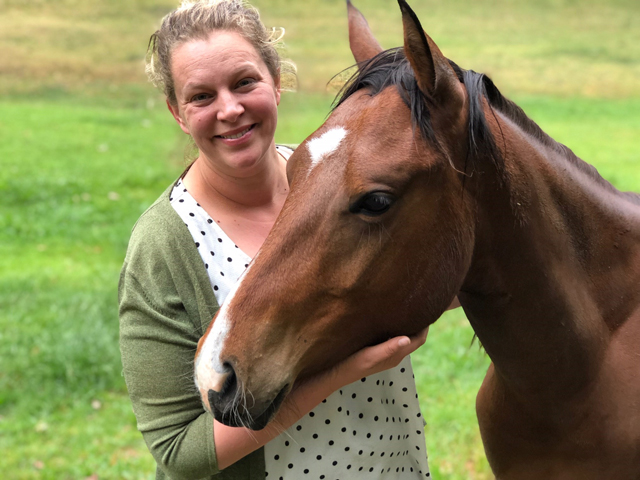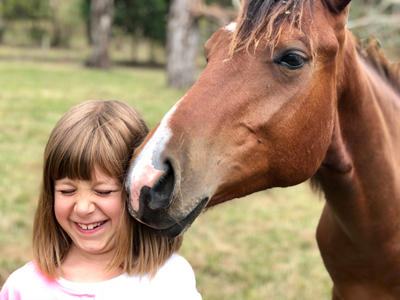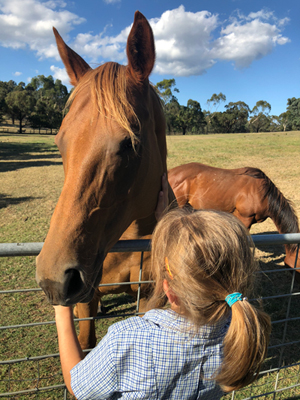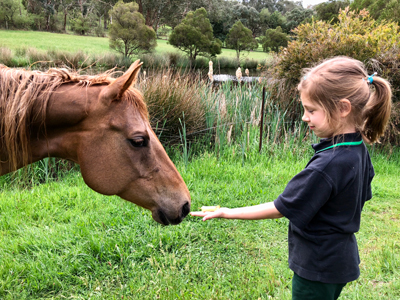Therapeutic Horseback Riding for Children with Autism Interview

Children with Autism Spectrum Have Immediate and Long-Term Benefits from Therapeutic Horseback Riding, Researchers Show
In the first large, randomized study of its kind, researchers at the University of Colorado Anschutz Medical Campus have shown a lasting reduction in irritability and other positive social and communication impacts on children with autism spectrum through therapeutic horse riding.
"There is growing evidence that human-animal interventions can improve emotional health and social wellness in youth, particularly those with autism spectrum disorder," said the study's principal investigator and lead author Robin Gabriels, PsyD, professor of psychiatry at the University of Colorado School of Medicine. "Our study was rigorous and the findings remarkable."
The initial report of the researchers' randomized study of therapeutic horseback riding (THR) with 127 children ages 6 to 16 years was published in the Journal of the American Academy of Child & Adolescent Psychiatry in 2015. It was the first to show that participating in 10-weeks of THR resulted in significant improvements in irritability, hyperactivity, social skills and word fluency compared to a barn activity control group that met at the riding center to learn about horses, but had no direct interaction with horses.
The researchers then did a 6-month follow-up of 44% of the participants from that initial study, published in a recent special issue of Frontiers in Veterinary Science. The study was the first to demonstrate that the initial benefits of 10-weeks of THR in this same population can have lasting benefits.
Specifically, this follow-up study revealed that the THR group maintained their reductions in irritability, but not hyperactivity compared to the children who just learned about horses at the riding center. At the same time, when examining just the THR group, the results indicated that children sustained their initial significant improvements in social communication and word fluency.
The research provides evidence to show that THR may be an intervention that leads to the longer-term maintenance of initial benefits gained from equine therapy.
Yet the physiological mechanisms behind this remain to be discovered.
Some theorize that children diagnosed with autism spectrum might gravitate toward horseback riding because they are more comfortable with familiar routines.
 "Horses are known to prefer the same routine, the same stall, the same path or route, and the same habits, similar to children with autism," wrote L. Eugene Arnold, MD, MEd, of The Ohio State University in an editorial in the Journal of the American Academy of Child & Adolescent Psychiatry about Gabriels' 2015 study. "More importantly, horses are content to be guided by nonverbal communication but are amenable to verbal instruction, allowing children to experience and practice the power of communication by controlling a much stronger force than themselves in ways within their repertoire."
"Horses are known to prefer the same routine, the same stall, the same path or route, and the same habits, similar to children with autism," wrote L. Eugene Arnold, MD, MEd, of The Ohio State University in an editorial in the Journal of the American Academy of Child & Adolescent Psychiatry about Gabriels' 2015 study. "More importantly, horses are content to be guided by nonverbal communication but are amenable to verbal instruction, allowing children to experience and practice the power of communication by controlling a much stronger force than themselves in ways within their repertoire."
He also noted that a horse's rhythmic stride can have a calming effect on the brain.
The study indicates that human interaction with animals can be beneficial on multiple levels.
"Most pet owners are only too aware of the 'feel-good factor' associated with pets in their lives. The important thing is that there is also a growing body of measurable scientific evidence showing the emotional, social and psychological benefits of interacting with animals," said Dr. Darren Logan, Head of Research at the WALTHAM Centre for Pet Nutrition, a division of Mars Petcare that has partnered with the National Institutes of Health Eunice Kennedy Shriver National Institute of Child Health and Human Development (NICHD) for the past 10 years to study human-animal interaction. "This impressive study, part of our partnership with NICHD, adds to this evidence and provides a positive indicator of how animal-assisted therapy can play a role in improving the developmental outcomes of children and youth in the future."
Dr. Gabriels, a licensed clinical psychologist who practices at Children's Hospital Colorado, said that based on these findings, THR might be a safe and effective adjunct intervention for treating children with autism, and one that might help reduce the need for higher medication doses to address symptoms of irritability within this population.
"This is just the beginning," she said. "We hope to conduct additional studies aimed at getting a better understanding of how exactly this form of therapy seems to benefit those with autism."
The study's co-authors include: Zhaoxing Pan; Noemie A. Guerin; Briar Dechant and Gary Mesibov.
 Interview with Mia Cobb, Leading Scientist in Human-Animal Interactions
Interview with Mia Cobb, Leading Scientist in Human-Animal Interactions
Question: What is therapeutic horseback riding?
Mia Cobb: PATH International define Therapeutic riding as, 'an equine-assisted activity for the purpose of contributing positively to the cognitive, physical, emotional and social well-being of individuals with special needs'.
Question: Did the study results showing that children with autism engaging in therapeutic horseback riding (THR) received both immediate and long-term benefits, surprise you?
Mia Cobb: There is growing evidence that appropriate animal-assisted interventions can improve emotional health and social wellness in young people, particularly those with autism spectrum disorder. Showing that most of these outcomes persist well beyond the duration of the intervention is important new information about the sustained benefits such interventions bring to human social and emotional health.
Question: What immediate and long-term benefits would children with autism receive from therapeutic horseback riding?
Mia Cobb: Previous research has shown that children with autism who participate in 10-weeks of therapeutic horseback riding showed significant improvements (in the short term) related to irritability, hyperactivity, social skills and word fluency.
This new research by the University of Colorado funded by the National Institutes of Health's Eunice Kennedy Shriver National Institute of Child Health and Human Development (NICHD) in partnership with Mars Petcare and WALTHAM, indicated that the initial improvements related to reductions in irritability and improvements in social and communication behaviours and word fluency, were sustained longer term (6 months).
Question: How can all children benefit from therapeutic horseback riding?
Mia Cobb: It's not as simple as 'apply child to horseback and see the benefits', which is important to understand. Whether a particular child might benefit from therapeutic riding needs to be considered carefully by the child and their parents, together with the child's clinical team.
Question: How does therapeutic horseback riding encourage social and communication skills?
Mia Cobb: That's an excellent question that researchers are excited to answer. For now, it's not entirely clear how animal assisted interventions such as therapeutic riding help to develop social and communication skills. Humans are naturally attracted to life-like forms (this is known as biophilia) so pets grab our attention from a very young early age. Being drawn to interact with them may help individuals in their social behaviour more generally and provide a great topic of conversation. The researchers in this study suggest benefits have to do with aspects including the rhythmic movement of horse-riding, the tactile experience of touching horses and the patterns/routine of scheduled interactions.
 Question: What other conditions can therapeutic horseback riding help teach and treat?
Question: What other conditions can therapeutic horseback riding help teach and treat? Mia Cobb: For those with ASD, equine assisted activities have also shown benefits in sensory processing, movement control, ASD symptom severity, and Quality of Life, whereas equine-assisted therapy studies reported improvements in motor control and adaptive living skills.
Question: Can you talk us through which animals are suitable as companion or therapy pets?
Mia Cobb: Dogs, cats, birds, fish, and other small furry animals, like rabbits and guinea pigs, can make great companions but each require different levels of care, expense, and time to keep them healthy and happy. Housing may also help to determine the type of pet that's most suitable for a particular person. Dogs tend to require more space and access to the outdoors, while cats and other pets are often content with an indoor-only lifestyle.
Only certain individual animals will be suitable as therapy animals, so it's important to recognise it's not a role for any dog, or any guinea pig.. Genetics, early experience, training, nutrition and healthcare all need to be considered to prepare them adequately for becoming an accredited therapy animal through a recognised organisation.
Interview by Brooke Hunter
MORE



